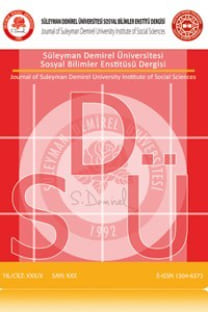DURAN VARLIK HARCAMALARININ İŞLETME SERMAYESİ YÖNETİMİ ÜZERİNE ETKİLERİ: ISTANBUL MENKUL KIYMETLER BORSASINDA İŞLEM GÖREN İMALAT İŞLETMELERİ ÜZERİNE BİR UYGULAMA
İşletme finansının en önemli konularından biri olan işletme sermayesi yönetimi, işletmenin normal olarak bir yıl içerisinde nakde çevrilebilir ekonomik değerlere yaptığı yatırımı; sabit varlık yatırımları (sermaye harcamaları) ise, uzun vadeli yatırımları ifade etmektedir. Bu çalışmanın amacı, sabit varlıklara yapılan yatırımları işletme sermayesi yönetimi açısından incelemek ve bu yatırımların işletme sermayesi yönetimi üzerindeki etkisini araştırmaktır. Yapılan regresyon analizi sonuçlarına göre, sabit varlık yatırımlarının işletme sermayesi yönetimi üzerinde önemli bir etkisi olduğu sonucuna ulaşılmıştır
Anahtar Kelimeler:
İşletme Sermayesi Yönetimi, Panel Regresyon
THE IMPACT OF FIXED ASSETS EXPENDITURES ON WORKING CAPITAL MANAGEMENT: AN APPLICATION ON MANUFACTURING ENTERPRISES IN ISTANBUL
Working capital management which is one of the most important issues of business financing, corresponds to the business’ investments which are made on economic values that can be converted into cash normally in oneyear while the fixed capital (capital expenditures) corresponds to the longterm investments. The aim of this paper is to investigate the investments made on fixed capital in terms of working capital management and to explore the effects of these investments on working capital management. According to the results of the regression analysis, the consequence that the fixed assets expenditure has a prominent effect on working capital management is proved
Keywords:
Working Capital Panel Regression, Net Liquid Balance,
___
- APPUHAMI, B.A R.(2008), “The Impact of Firms Capital Expenditure on Working Capital Management: An Empricial Study Across Indutries in Thailand”, International Management Review. Vol.4 No.1, 8-21.
- BUYUKSALVARCI, A. and ABDIOĞLU H. (2010), “Kriz Öncesi ve Kriz Dönemlerinde Işletmelerde Çalışma Sermayesi Gereksiniminin Belirleyicileri: İMKB Imalat Sanayi Şirketleri Üzerine Ampirik Bir Çalışma”, Atatürk Üniversitesi İktisadi İdari Bilimler Fakültesi Dergisi. 24(2), 47-71.
- CHIOU, J.R., CHENG, L. and WU, H.W. (2006), “The Determinants of Working Capital Management”, Journal of American Academy of Business Cambridge. 10(1), 149-155.
- COSKUN, E. and KOK, D. (2011), “Çalışma Sermayesi Politikalarının Kârlılık Üzerine Etkisi: Dinamik Panel Uygulaması”, Ege Akademik Bakış Dergisi. 11, 75-85.
- ERDINÇ, S.B. (2008), “Konaklama Işletmelerinde Işletme Sermayesi Yönetiminin Incelenmesi”, Afyon Kocatepe Üniversitesi İktisadi İdari Bilimler Fakültesi Dergisi. , 223-236.
- FAZZARI, S.M. and PETERSEN, B.C. (1993), “Working Capital and Fixed Investment. New Evidence on Financing Constraints”, The Rand Journal of Economics. 24(3), 328-342.
- GENTRY, J.A., MEHTA, D.R., BHATTACHARYYA, S.K., COBBAUT, R. and SCARINGELLA, J.L. (1979), “An International Study of Management Perceptions of The Working Capital Process”, Journal of International Business Studies. 10(1), 28-38.
- HAWAWINI, G., VIALLET, C. and VORA, A. (1986), “Industry Influence on Corporate Working Capital Decisions”, Sloan Management Review. 27(4), 15-24.
- KIESCHNICK, R., LAPLANTE, M. and MOUSSAWI, R. (2006). “Corporate Working Capital Management: Determinants and Consequences”, http://libra.msra.cn/Publication/13340891/corporate-workingcapital-management-determinants-and-consequences ,20/02/2013
- KIM, C.S., MAUER, D.C. and SHERMAN, A.E. (1998). “The Determinants of Corporate Liquidity: Theory and Evidence”, Journal of Financial and Quantitative Analysis. 33(3), 335-359.
- LARGAY, J. and STICKNEY C. (1980), “Cash Flows, Ratio Analysis and The W.T. Grant Company Bankruptcy”, Financial Analyst Journal. 36(4), 51-54.
- LAZARIDIS, I. and TRYFONIDIS, D. (2006), “Relationship Between Working Capital Management and Profitability of Listed Companies in the Athens Stock Exchange”, Journal of Financial Management and Analysis. 19(1), 26-35.
- NARASIMHAN, M.S. and MURTY, L.S. (2001), “Emerging Manufacturing Industry: A Financial Perspective”, Management Review. June, 105- 112.
- NAZIR, M.S. and AFZA, T. (2008), “On The Factor Determining Working Capital Requirements”, Proceedings of ASBBS. 15(1), 293-301. NUNN, K. (1981), “The Strategic Determinants of Working Capital: A Product-line Perspective”, The Journal Of Financial Research, Fall. 207-219.
- OPLER, T., PINKOWITZ, L., STULZ, R. and WILLIAMSON, R. (1999), “The Determinants and Implications of Corporate Cash Holdings”, Journal of Financial Economics. 52(1), 3-46.
- OZ, Y. and GUNGOR, B. (2007). “Çalışma Sermayesi Yönetiminin Firma Kârlılığı Uzerine Etkisi: Imalat Sektörüne Yönelik Panel Veri Analizi”, Atatürk Üniversitesi Sosyal Bilimler Enstitüsü Dergisi.
- OZTURK, M.B. and DEMIRGUNEŞ, K. (2008), “Işletme Sermayesi Gereksinimini Etkileyen Değişkenler Üzerine İMKB’de Bir Uygulama”, Finans, Politik ve Ekonomik Yorumlar Dergisi. 45(516), 47-56.
- REHMAN, A. (2006), “Working Capital Management and Profitability: Case of Pakistani Firms”, Comsats Institute of İnformation Tecnology Islamabad.
- SHIN, H.H. and SOENEN, L. (1998), “Efficiency of Working Capital Management and Corporate Profitability”, Financial Practice and Education. 8(2), 37-45.
- SMITH, V.K. (1973), “State of The Art of Working Capital Management”, Financial Management, Autumn. 50-55.
- VALIPOUR, H., MORADI, J. and KARIMI, K. (2010), “The Impact of Expenditure on Working Capital Management: Empirical Evidences From Tehran Stock Exchange”, International Research Journal of Finance and Economics. 85, 14-25.
- WEINRAUB, H. and VISSCHER, S. (1998), “Industry Practice Related to Aggressive/Conservative Working Capital Policies”, Journal of Financial and Strategic Decisions. 11(2), 39-46.
- YUCEL, T. and KURT, G. (2002). “Nakit Dönüş Süresi, Nakit Yönetimi ve Kârlılık: İMKB Şirketleri Üzerine Ampirik Bir Çalışma”, İMKB Dergisi. 6(22), 1-15.
- Yayın Aralığı: Yılda 3 Sayı
- Başlangıç: 2005
- Yayıncı: Süleyman Demirel Üniversitesi
